Cinder Block Bench: A Step-by-Step Guide to Building Your Own

Introduction to the Cinder Block Bench
If you’re looking to add a unique touch to your outdoor space, building a cinder block bench may be just the project you need. This versatile and durable seating solution not only offers practicality but also allows for endless creativity. Cinder blocks are affordable, easy to work with, and can transform any backyard or garden into a cozy nook for relaxation or social gatherings.
Imagine lounging with friends over barbecues or enjoying quiet mornings sipping coffee while surrounded by nature—all on your very own custom-built bench. Whether you’re an experienced DIY enthusiast or just starting out, creating a cinder block bench is a rewarding endeavor that enhances your outdoor living experience. Let’s dive into how you can make this happen!
Materials and Tools Needed
To create your own cinder block bench, you’ll need a few essential materials. First up are the cinder blocks themselves. Aim for at least ten to twelve blocks, depending on your desired bench size.
Next, grab some concrete adhesive or construction glue. This will help secure the blocks together and provide stability.
You’ll also want to invest in a sturdy wooden plank for the seating surface. A 2×4 or similar dimension works well and can be cut to fit your preferred length.
Don’t forget about tools! A level ensures everything is even, while a rubber mallet helps with positioning without damaging the blocks. Having safety gloves on hand keeps your hands protected during the build process.
With these materials and tools ready, you’re set to start building that stylish cinder block bench!
Steps to Building Your Own Cinder Block Bench
Start by choosing a flat area in your yard or garden. This will be the foundation for your cinder block bench. Clear any debris, ensuring a stable surface.
Next, gather your cinder blocks and arrange them in two parallel rows. Space them evenly to create the desired length of your bench. For added stability, you can use construction adhesive between the blocks.
Once you’ve set up the base, stack additional cinder blocks on top of each row to build height. Make sure they fit snugly together for support.
After reaching your preferred height, consider adding wooden planks across the top for comfort. These can serve as seating and add an aesthetic touch to your creation.
Step back and check if everything is even and secure before testing out your new bench. Enjoy this DIY project as it comes together!
Creative Design Ideas for Your Bench
Transforming your cinder block bench into a unique piece can add personality to any outdoor space. Start by painting the blocks in vibrant colors or using stencils for creative designs. This will not only protect them but also bring a pop of color to your garden.
Consider adding cushions or throw pillows for comfort and style. Choose weather-resistant fabrics to ensure durability against the elements. You could even create a themed seating area with patterns that match your patio decor.
Integrate plants by stacking blocks horizontally and placing potted flowers on top, turning your bench into a beautiful green oasis. Alternatively, you can use hollowed-out cinder blocks as planters on either side of the seating surface.
For those who enjoy DIY projects, think about attaching wooden planks on top for an added touch of warmth. Mixing materials creates visual interest while maintaining functionality in your outdoor setting.
Maintenance and Care Tips
To keep your cinder block bench looking great, start with regular cleaning. A simple solution of soap and water will do the trick. Use a soft brush to scrub any dirt or stains.
Inspect your bench periodically for cracks or chips. Cinder blocks are durable, but they can wear over time. If you spot any damage, consider using mortar to patch it up.
Protect your bench from harsh weather by applying a sealant every few years. This helps prevent moisture absorption and prolongs its life.
If you have plants around your bench, be cautious not to let soil accumulate on the surface. It can trap moisture and lead to mold growth.
Consider adding cushions for comfort and style. Just remember to store them away during inclement weather to maintain their quality longer.
Benefits of Using a Cinder Block Bench
Cinder block benches offer a budget-friendly solution for any outdoor space. They are made from durable materials, ensuring longevity and resistance to harsh weather conditions.
Their versatility is another major advantage. You can customize the size and shape based on your needs or the layout of your garden. This adaptability makes them perfect for both small patios and expansive yards.
Additionally, cinder blocks provide an industrial aesthetic that complements modern designs beautifully. You can enhance this look by adding cushions or decorative elements to create a cozy seating area.
Another benefit lies in their strength; these benches can support significant weight without compromising stability. This means you don’t have to worry about wear over time, making them ideal for gatherings with family and friends.
Constructing a cinder block bench involves minimal tools and effort—perfect for DIY enthusiasts looking to add flair to their outdoor spaces without extensive labor.
Conclusion
Building your own cinder block bench is a rewarding project that combines functionality with creativity. With simple materials and tools, you can create a sturdy seating option for your outdoor space or garage. This guide has provided all the steps needed to construct your bench, along with ideas to personalize it.
Maintaining your cinder block bench requires minimal effort, ensuring its longevity and usability. The benefits of using such a versatile material are clear: durability, affordability, and endless design possibilities make the cinder block bench an excellent addition to any setting.
Whether you’re looking for extra seating in your backyard or a unique piece of decor, this DIY project offers both practicality and style. Embrace the challenge and enjoy crafting something truly special!





